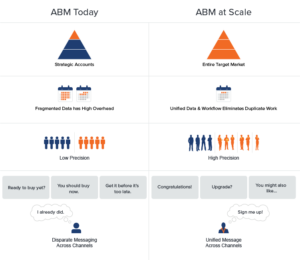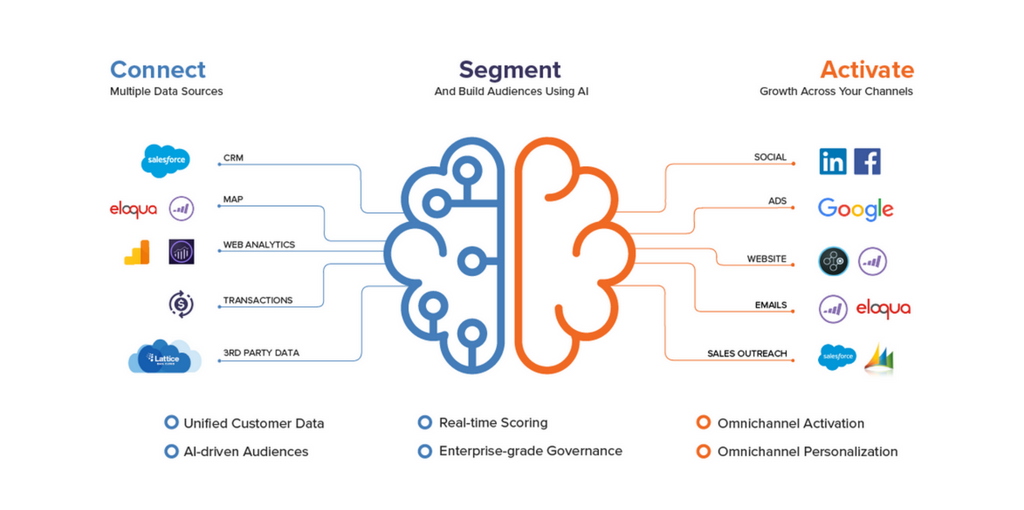ABM @ Scale: The Challenge
August 13, 2018This is part 1 of a 2 part blog series. In this post, I explore the key reasons why marketers are challenged with scaling their ABM programs and how that hinders their ability to drive impact. In Part 2, our VP of Product Chitrang Shah describes how Lattice Atlas, our latest release, enables marketers to successfully scale their ABM programs.
Account-based marketing (ABM) has rapidly gone mainstream in the last year. According to ITSMA research, marketers are now allocating 28% of their budget to ABM, up from 20% last year. Yet only 1 out of 5 marketers are realizing the benefits of ABM (Forrester Research study on ABM).
As practiced today, ABM is hard work. It’s especially hard to scale beyond the first pilot program into production across all target accounts. Scaling ABM programs has many facets, each of which is challenging:
- Number of Accounts: From 50 accounts to 5000 or even 50,000 accounts
- Account Focus: From “Strategic accounts” to enterprise and mid-market accounts
- Target Account Profile: From a single ICP to dozens of ICPs.
- Lifecycle Stage: From net-new customer acquisition for a single product line to new customer acquisition, cross-sell, up-sell, and retention across multiple product lines.
In the pursuit of consistent and personalized experiences across all channels, marketers have purchased many marketing and sales applications. Each of these applications has its own data, segmentation engine, activation layer, and reporting structure. Since the applications don’t share data with each other, and segmentation is often built on the limited data they have access to, the end-user experience is completely broken.
Marketers get around this by challenge by either running very manual campaigns using email and SDRs or relying entirely on diffuse channels like display or retargeting. The disconnect between different channels (and applications that don’t talk to each other) leads to a fragmented customer experience.

Figure 1: Comparing ABM @ Scale with Typical ABM Programs Today
In this post, I will dig into the root cause that prevents scaling and propose the emerging solution to this problem. In our next post, our VP of Product Chitrang Shah will describe this solution in greater detail.
Why B2B Marketing Can’t Scale ABM
The good news is that we are capturing more data than ever about our prospects and customers in a range of applications – CRM, marketing automation, web visitor logs, third party intent, DMP, ERP, support systems, etc.
The bad news is that all this data is fragmented and disconnected. Ops teams and IT spend weeks on end cobbling together the data needed for audience creation, activation and measurement. Most of this work is done in spreadsheets or data-lakes. Spreadsheets are error-prone, hard to maintain, and don’t scale. Data-lakes require IT involvement across the campaign lifecycle which impacts agility.
What’s an ABM practitioner to do?
David Raab, founder of the Customer Data Platform Institute, makes the case for a new technology called a Customer Data Platform (CDP) specifically built to help marketers drive personalized marketing. According to David, “Modern marketing requires a unified view of customer data to support coordinated, optimal treatment of each customer and prospect across all channels throughout the customer life cycle. Customer Data Platforms allow marketers to create this unified view.”
Similarly, Gartner says a CDP is an “integrated customer database managed by marketers that unifies a company’s customer data from online and offline channels to enable modeling and drive customer experience.”
Our point of view is that a CDP solves the “data problem” for scaling ABM. Because whether you call it a CDP or not, marketers ultimately need a solution that does the following in order to scale ABM.
- Unified Customer Data: The ability to not just aggregate and consolidate all your customer data, but also to map and organize that data by account, buying center and contact hierarchies. Gartner puts it best in a recent article: “unify customer data from disparate sources, linking identity, behavior, purchase and demographics in a single record.” This also includes adding in all available 3rd party data attributes about your customers.
- AI-Driven Audiences: With the volume and variety of data available at their fingertips, marketers need AI to predict and identify who will buy, what they’ll buy and when. This means being able to not just score accounts and contacts, but also using AI to identify whether buying committees have formed, assess the buying stage and identify the next best offer.
- Omnichannel Activation and Personalization: Being able to take these audiences and run hyper-personalized campaigns against them via every relevant channel. ABM thrives on omni-channel engagement, and the ability to deliver consistent messages to buyers across each channel is critical here.
- Enterprise Grade Governance: The ability to ensure that your customer data is safe and handled with care. As the crown jewel of any business, marketers must ensure that customer data is handled with care – and ensure that the solution appropriately complies with GDPR and all other privacy and security standards.
ABM practitioners have not had a packaged solution that meets the criteria laid out above …until now. Read our next post to learn why we are announcing Lattice Atlas, the industry’s first platform for driving ABM at scale.


